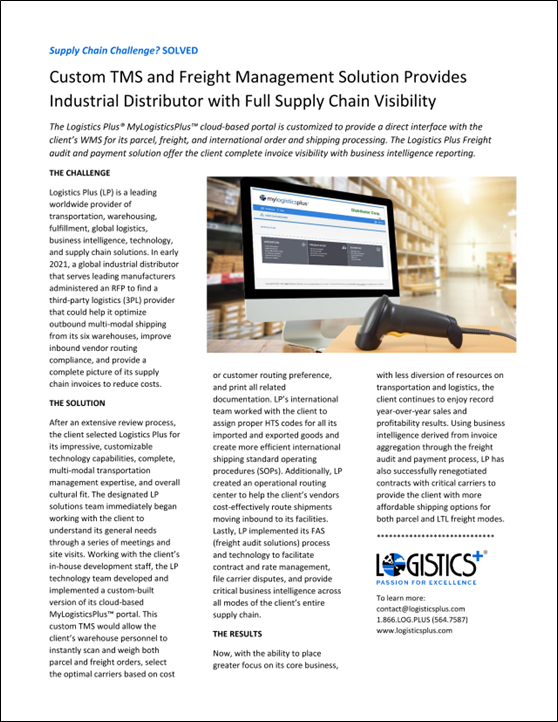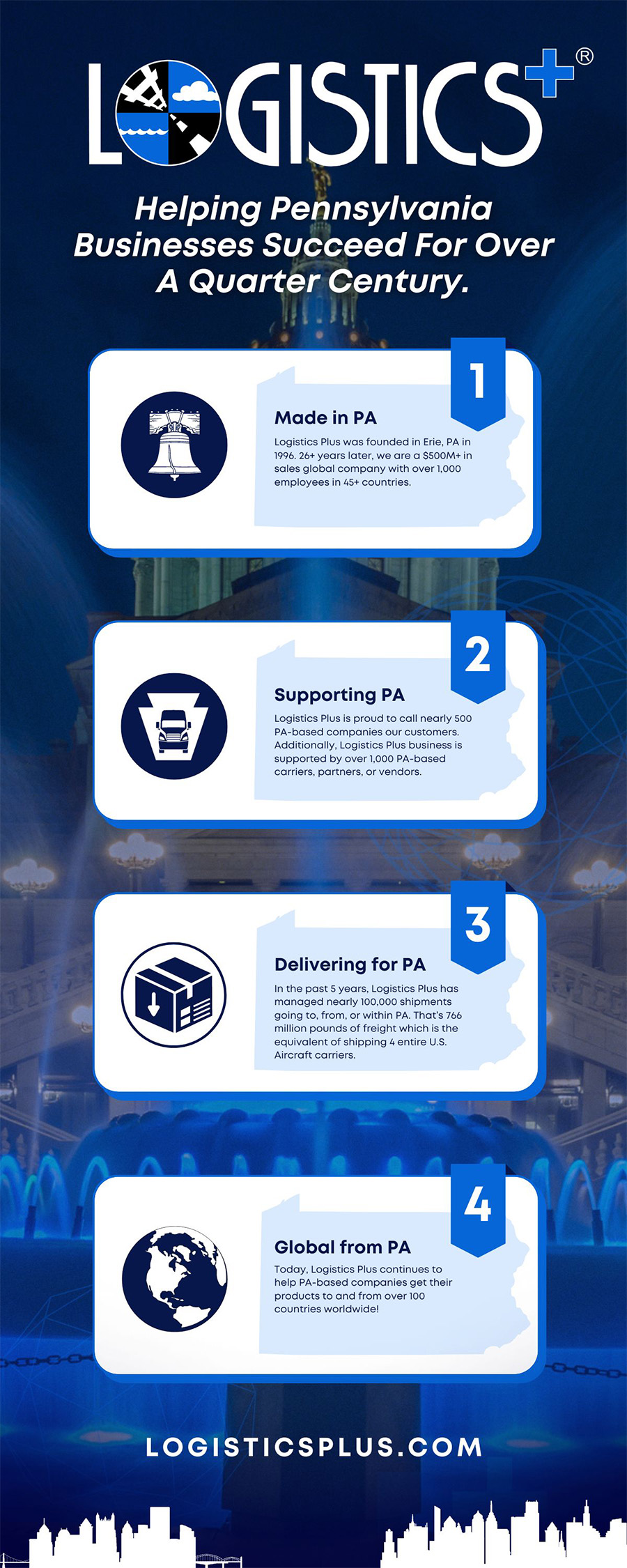
by logisticsplus | Jun 21, 2023 | News

Logistics Plus Recognized with Another Top Supply Chain Project Award
It’s the fifth straight year and the seventh time that Supply & Demand Chain Executive
has recognized Logistics Plus for a top supply chain project.
 ERIE, PA (June 21, 2023) – Logistics Plus, Inc. (LP), a leading worldwide provider of transportation, logistics, and supply chain solutions, is proud to announce it has been selected by Supply & Demand Chain Executive, an industry-leading publication covering the entire global supply chain, as a recipient of a Top Supply Chain Projects Award for 2023. This is the fifth consecutive year that Logistics Plus has been honored for managing a top supply chain project and the seventh time in the past eight years.
ERIE, PA (June 21, 2023) – Logistics Plus, Inc. (LP), a leading worldwide provider of transportation, logistics, and supply chain solutions, is proud to announce it has been selected by Supply & Demand Chain Executive, an industry-leading publication covering the entire global supply chain, as a recipient of a Top Supply Chain Projects Award for 2023. This is the fifth consecutive year that Logistics Plus has been honored for managing a top supply chain project and the seventh time in the past eight years.
 The annual Top Supply Chain Projects Award spotlights successful and innovative transformation projects that deliver bottom-line value to small, medium, and large enterprises across various supply chain functions. These projects show how supply chain solution and service providers help their customers and clients achieve supply chain excellence and prepare their supply chains for success.
The annual Top Supply Chain Projects Award spotlights successful and innovative transformation projects that deliver bottom-line value to small, medium, and large enterprises across various supply chain functions. These projects show how supply chain solution and service providers help their customers and clients achieve supply chain excellence and prepare their supply chains for success.
The supply chain project submitted by Logistics Plus that earned this year’s recognition involved the development of a custom TMS solution bundled with complete multi-mode freight management, freight audit, and freight payment services. The case study can be viewed online.
“This project is a great showcase for our technology solutions,” said Jim Berlin, Founder and CEO of Logistics Plus. “Today, information technology and business intelligence are just as important as moving freight for supply chain managers looking to increase shipment visibility and reduce costs. Thank you to Supply & Demand Chain Executive for recognizing us, once again, with a top supply chain award.”
About Supply & Demand Chain Executive
Supply & Demand Chain Executive is the only supply chain publication covering the entire global supply chain, focusing on trucking, warehousing, packaging, procurement, risk management, professional development, and more. Learn more at www.SDCExec.com.
About Logistics Plus, Inc.

Audio Comments
Logistics Plus, Inc. is a 21st-century logistics company and a leading worldwide provider of transportation, warehousing, fulfillment, global logistics, business intelligence, technology, and supply chain solutions. Logistics Plus was founded in 1996 and today has annual global sales of over $500M with more than 1,000 employees located in 45+ countries worldwide. It is recognized as one of the fastest-growing privately-owned logistics companies, a top 3PL provider, a top 100 logistics company, a top freight brokerage and warehousing provider, and a great place to work. With a Passion For Excellence™, its employees put the PLUS in LOGISTICS by doing the big things properly, plus the countless little things that together ensure complete customer satisfaction and success.




by logisticsplus | Jun 20, 2023 | News
FOR IMMEDIATE RELEASE
Logistics Plus is Named a 2023 G75 Green Supply Chain Partner by Inbound Logistics
The annual list recognizes 75 leading companies focused on green supply chain management.
 ERIE, PA (June 20, 2023) – Logistics Plus, Inc. (LP), a leading worldwide provider of transportation, logistics, and supply chain solutions, is proud to announce that it has been named a 2023 G75 Green Supply Chain Partner by Inbound Logistics magazine. The list, curated annually by the editors of Inbound Logistics, recognizes 75 companies going above and beyond to prioritize green initiatives and help global supply chains become more sustainable.
ERIE, PA (June 20, 2023) – Logistics Plus, Inc. (LP), a leading worldwide provider of transportation, logistics, and supply chain solutions, is proud to announce that it has been named a 2023 G75 Green Supply Chain Partner by Inbound Logistics magazine. The list, curated annually by the editors of Inbound Logistics, recognizes 75 companies going above and beyond to prioritize green initiatives and help global supply chains become more sustainable.
“Inbound Logistics editors have determined that Logistics Plus is one of the 75 honorees that ‘walk the walk’ when it comes to commitment to supply chain sustainability,” said Felecia Stratton, Editor for Inbound Logistics. “Given the global environment, it is truly an accomplishment this year.”
“Economic, environmental, and social sustainability have always been a part of our growth strategy,” said Yuriy Ostapyak, COO for Logistics Plus. “By doing what’s right, like investing in EV equipment, being a 12-year SmartWay Transport Partner, and becoming the first global 3PL to achieve plastic neutrality through the Ocean Integrity Blue Ocean Program, we continue to do our best to grow without compromising the future.”
The updated G75 list appears in the June 2023 Sustainability edition of Inbound Logistics magazine in both print and digital formats. View the Logistics Plus profile, including a photo of LP warehouse electric forklifts, in the digital edition at https://magazine.inboundlogistics.com/view/852008018/50/.
About Inbound Logistics
Inbound Logistics (IL) is the pioneering magazine empowering demand-driven enterprises. IL’s educational mission is to guide businesses to efficiently manage logistics, reduce and speed inventory, and neutralize transportation cost increases by aligning supply to demand and adjusting enterprise functions to support that paradigm shift. More information about demand-driven enterprise practices is available at inboundlogistics.com.
About Logistics Plus, Inc.
 Logistics Plus, Inc. is a 21st-century logistics company that provides freight transportation, warehousing, fulfillment, global logistics, business intelligence, and supply chain management solutions through a worldwide network of talented and caring professionals. Jim Berlin founded the company nearly 26 years ago in Erie, PA. Today, Logistics Plus is a highly regarded, fast-growing, and award-winning transportation and logistics company. With its trademark Passion For Excellence™, Logistics Plus employees put the ‘plus’ in logistics by doing the big things properly, plus the countless little things that ensure complete customer satisfaction and success.
Logistics Plus, Inc. is a 21st-century logistics company that provides freight transportation, warehousing, fulfillment, global logistics, business intelligence, and supply chain management solutions through a worldwide network of talented and caring professionals. Jim Berlin founded the company nearly 26 years ago in Erie, PA. Today, Logistics Plus is a highly regarded, fast-growing, and award-winning transportation and logistics company. With its trademark Passion For Excellence™, Logistics Plus employees put the ‘plus’ in logistics by doing the big things properly, plus the countless little things that ensure complete customer satisfaction and success.
The Logistics Plus® network includes offices, warehouses, and agents located in Erie, PA; Aurora, CO; Buffalo, NY; Charlotte, NC; Chicago, IL; Chino, CA; Cincinnati, OH; Cleveland, OH; Colton, CA; Dallas, TX; Dayton, NJ; Des Moines, IA; Fontana, CA; Haslet TX; Honolulu, HI; Houston, TX; Jamestown, NY; Laredo, TX; Lexington, NC; Los Angeles, CA; Meadville, PA; Miami, FL; New York, NY; Norfolk, VA; Olean, NY; Phoenix, AZ; Riverside, CA; San Francisco, CA; Tulsa, OK; Vancouver, WA; Australia; Belgium; Brazil; Canada; China; Colombia; Czech Republic; Egypt; France; Germany; India; Indonesia; Japan; Kazakhstan; Kenya; Libya; Malaysia; Mexico; Netherlands; Poland; Saudi Arabia; Singapore; South Africa; Taiwan; Thailand; Turkey; UAE; Uganda; Ukraine; and Vietnam; with additional agents around the world. For more information, visit www.logisticsplus.com or follow @LogisticsPlus on Twitter.

Audio Comments
Media Contact:
Scott G. Frederick
CMO & LTL Carrier Relations
Logistics Plus, Inc.
(814) 240-6881
scott.frederick@logisticsplus.com
Click the image below to download the Logistics Plus logo:


by logisticsplus | Jun 19, 2023 | News
 Logistics Plus Customs Brokerage Manager Gretchen Blough made another appearance on Marketplace to discuss international trade and China tariffs that are still in place from the Trump era.
Logistics Plus Customs Brokerage Manager Gretchen Blough made another appearance on Marketplace to discuss international trade and China tariffs that are still in place from the Trump era.
Gretchen commented on how the tariffs have made U.S. manufacturers more competitive. “These additional tariffs on everything, the additional duties on everything, gives the U.S. manufacturers a more level playing field,” said Blough, who works at Logistics Plus in Erie, Pennsylvania. Gretchen added, “The landed cost goes up on these imported goods, and therefore the U.S. manufacturer is able to better compete with them.”
The complete podcast (Some U.S. manufacturers are still benefiting from Trump-era tariffs) is below and available online at https://www.marketplace.org/2023/06/16/some-u-s-manufacturers-are-still-benefiting-from-trump-era-tariffs/
Marketplace® is a nonprofit news organization on a mission to raise the economic intelligence of the country. For more than 30 years, they have helped people become smarter about the economic forces that touch their daily lives through the unorthodox story, the casual conversation, and the unexpected angle on the news.

by logisticsplus | Jun 16, 2023 | News
 As illustrated in this infographic, Logistics Plus® has been helping Pennsylvania businesses succeed statewide and worldwide for over a quarter century. The company was founded in Erie, PA, in 1996 and remains the home of the Logistics Plus Global Headquarters today.
As illustrated in this infographic, Logistics Plus® has been helping Pennsylvania businesses succeed statewide and worldwide for over a quarter century. The company was founded in Erie, PA, in 1996 and remains the home of the Logistics Plus Global Headquarters today.
Click the image below to download a PDF version.


by logisticsplus | Jun 13, 2023 | News
 Logistics Plus (LP) China is excited to announce the opening of a new office in Shenzhen! The Shenzhen office will be managed by Leo Liu, who has supported Logistics Plus China since its opening in 2006. With Leo and his team’s expertise in freight forwarding operations, the LP Shenzhen office will specialize in the following:
Logistics Plus (LP) China is excited to announce the opening of a new office in Shenzhen! The Shenzhen office will be managed by Leo Liu, who has supported Logistics Plus China since its opening in 2006. With Leo and his team’s expertise in freight forwarding operations, the LP Shenzhen office will specialize in the following:
- Imports and exports
- International air freight
- International ocean freight
- Customs clearance
- Global supply chain solutions
Shenzhen, bordering Hong Kong to the south, is a major sub-provincial city and one of China’s special economic zones. Shenzhen is the third most populous city by urban population in China after Shanghai and Beijing. Shenzhen is a global center in technology, research, manufacturing, business and economics, finance, tourism, and transportation, and the Port of Shenzhen is the world’s fourth busiest container port.
 Leo Liu (General Manager)
Leo Liu (General Manager)
Email: leo.liu@logisticsplus.com
Phone: +86.755.28430951
Mobile: +86.13410347597
Logistics Plus Shenzhen, China
542 Minzhi Avenue, Minqiang Community
The Valley Of Wisdom Innovation Plaza
Phase 4, building 2, office A207
Longhua district, Shenzhen city
Guangdong Province, China 518000
For any requests involving Shenzhen, please email leo.liu@logisticsplus.com or china@logisticsplus.com. We thank you for all current business and future opportunities, and we look forward to assisting you.


by logisticsplus | Jun 7, 2023 | News
 Working with contacts in combat positions in Ukraine, Logistics Plus funded, procured, and outfitted two custom-equipped vans set up as mobile trauma units, and last week we delivered them to Bakhmut. These vans were outfitted with the gear and equipment specifically requested by the Ukrainian field medics who will operate them. Field medics provide front-line mobile trauma care to address injuries that often prove fatal when not treated until the wounded reach a field hospital but can be non-fatal if treatment is provided more swiftly.
Working with contacts in combat positions in Ukraine, Logistics Plus funded, procured, and outfitted two custom-equipped vans set up as mobile trauma units, and last week we delivered them to Bakhmut. These vans were outfitted with the gear and equipment specifically requested by the Ukrainian field medics who will operate them. Field medics provide front-line mobile trauma care to address injuries that often prove fatal when not treated until the wounded reach a field hospital but can be non-fatal if treatment is provided more swiftly.
We are proud of this contribution and hope it helps make a real impact. Learn more about Logistics Plus activities in Ukraine at www.logisticsplus.com/rebuilding-ukraine.



 ERIE, PA (June 21, 2023) – Logistics Plus, Inc. (LP), a leading worldwide provider of transportation, logistics, and supply chain solutions, is proud to announce it has been selected by Supply & Demand Chain Executive, an industry-leading publication covering the entire global supply chain, as a recipient of a Top Supply Chain Projects Award for 2023. This is the fifth consecutive year that Logistics Plus has been honored for managing a top supply chain project and the seventh time in the past eight years.
ERIE, PA (June 21, 2023) – Logistics Plus, Inc. (LP), a leading worldwide provider of transportation, logistics, and supply chain solutions, is proud to announce it has been selected by Supply & Demand Chain Executive, an industry-leading publication covering the entire global supply chain, as a recipient of a Top Supply Chain Projects Award for 2023. This is the fifth consecutive year that Logistics Plus has been honored for managing a top supply chain project and the seventh time in the past eight years. The annual Top Supply Chain Projects Award spotlights successful and innovative transformation projects that deliver bottom-line value to small, medium, and large enterprises across various supply chain functions. These projects show how supply chain solution and service providers help their customers and clients achieve supply chain excellence and prepare their supply chains for success.
The annual Top Supply Chain Projects Award spotlights successful and innovative transformation projects that deliver bottom-line value to small, medium, and large enterprises across various supply chain functions. These projects show how supply chain solution and service providers help their customers and clients achieve supply chain excellence and prepare their supply chains for success.




 Logistics Plus, Inc. is
Logistics Plus, Inc. is 

 Logistics Plus Customs Brokerage Manager
Logistics Plus Customs Brokerage Manager 
 As illustrated in this infographic, Logistics Plus® has been helping Pennsylvania businesses succeed statewide and worldwide for over a quarter century. The company was founded in Erie, PA, in 1996 and remains the home of the Logistics Plus
As illustrated in this infographic, Logistics Plus® has been helping Pennsylvania businesses succeed statewide and worldwide for over a quarter century. The company was founded in Erie, PA, in 1996 and remains the home of the Logistics Plus 

 Logistics Plus (LP) China is excited to announce the opening of a new office in Shenzhen! The
Logistics Plus (LP) China is excited to announce the opening of a new office in Shenzhen! The  Leo Liu (General Manager)
Leo Liu (General Manager)

 Working with contacts in combat positions in Ukraine,
Working with contacts in combat positions in Ukraine, 